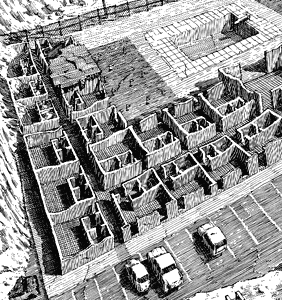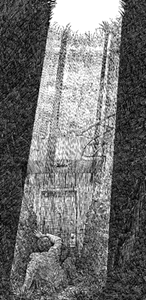 The
overall structure was laid out on the familiar "U" plan, and at the base
of the "U" was the communal sanctuary. By far the largest and grandest
room of the complex, the sanctuary contained a magnificent altar covered
entirely in sheets of plasticus petrificus or, as it was called by the
ancients, "Formica." Behind the altar and mounted on the wall stood a beautifully
crafted unit that contained several rows of identical slots, each with
a number apparently corresponding to a tomb. Offerings form friends and
relatives of the deceased were probably placed in a particular slot once
the tomb had been sealed. Behind the sanctuary was the room in which the
sacrificial meals were prepared. Beyond this area was the great courtyard,
in the center of which was the ceremonial pool. Prior to the ceremony within
the tomb, each body was apparently washed in the pool, which was also fed
by the sacred spring. Specially marked funerary game areas intended to
occupy the spirits of the dead during eternal life were located around
the sacred pool and were accessible to each of the tombs through sliding
panels. The
overall structure was laid out on the familiar "U" plan, and at the base
of the "U" was the communal sanctuary. By far the largest and grandest
room of the complex, the sanctuary contained a magnificent altar covered
entirely in sheets of plasticus petrificus or, as it was called by the
ancients, "Formica." Behind the altar and mounted on the wall stood a beautifully
crafted unit that contained several rows of identical slots, each with
a number apparently corresponding to a tomb. Offerings form friends and
relatives of the deceased were probably placed in a particular slot once
the tomb had been sealed. Behind the sanctuary was the room in which the
sacrificial meals were prepared. Beyond this area was the great courtyard,
in the center of which was the ceremonial pool. Prior to the ceremony within
the tomb, each body was apparently washed in the pool, which was also fed
by the sacred spring. Specially marked funerary game areas intended to
occupy the spirits of the dead during eternal life were located around
the sacred pool and were accessible to each of the tombs through sliding
panels.
Surrounding almost the entire
complex was a vast flat area, marked with parallel white lines. In several
of the spaces stood freely interpreted metal sculptures of animals. To
avoid the misunderstanding that often arises with free interpretation,
each sculpture was clearly labeled. They were inscribed with such names
as Cougar, Impala, Ram, Skylark, and Thunderbird, to name but a few. The
importance of animal worship in Yank burial customs has never been more
clearly illustrated. |
 He
had been working on the site, and his words guide us through the treasures
of the ancient North Americans: "The hard rock began to give way and then
collapsed. I feel into a deep pit and was knocked out. When I came to,
I found myself looking at the entrance to what we now call Room 26. Now
that the entire site has been excavated, it is clear that we have uncovered
a major religious center where bodies of believers were given last rites
and prepared for their journey to the next world. Although some of the
societyís curious customs still baffle us, the meanings of most have become
clear upon study of this rich cache of artifacts.
He
had been working on the site, and his words guide us through the treasures
of the ancient North Americans: "The hard rock began to give way and then
collapsed. I feel into a deep pit and was knocked out. When I came to,
I found myself looking at the entrance to what we now call Room 26. Now
that the entire site has been excavated, it is clear that we have uncovered
a major religious center where bodies of believers were given last rites
and prepared for their journey to the next world. Although some of the
societyís curious customs still baffle us, the meanings of most have become
clear upon study of this rich cache of artifacts. This
is the door to the outer chamber of the tomb as I first saw it when I awoke
from my fall. The seal to the outer chamber, (Number 22) was still in place
and intact after 2,000 years. The words on the seal are the opening phrase
of the traditional blessing offered at the sacramental meal. The consecrated
elements of that ceremony (Numbers 17, 19, 20) are at the left of the door.
The tips of
This
is the door to the outer chamber of the tomb as I first saw it when I awoke
from my fall. The seal to the outer chamber, (Number 22) was still in place
and intact after 2,000 years. The words on the seal are the opening phrase
of the traditional blessing offered at the sacramental meal. The consecrated
elements of that ceremony (Numbers 17, 19, 20) are at the left of the door.
The tips of  The
overall structure was laid out on the familiar "U" plan, and at the base
of the "U" was the communal sanctuary. By far the largest and grandest
room of the complex, the sanctuary contained a magnificent altar covered
entirely in sheets of plasticus petrificus or, as it was called by the
ancients, "Formica." Behind the altar and mounted on the wall stood a beautifully
crafted unit that contained several rows of identical slots, each with
a number apparently corresponding to a tomb. Offerings form friends and
relatives of the deceased were probably placed in a particular slot once
the tomb had been sealed. Behind the sanctuary was the room in which the
sacrificial meals were prepared. Beyond this area was the great courtyard,
in the center of which was the ceremonial pool. Prior to the ceremony within
the tomb, each body was apparently washed in the pool, which was also fed
by the sacred spring. Specially marked funerary game areas intended to
occupy the spirits of the dead during eternal life were located around
the sacred pool and were accessible to each of the tombs through sliding
panels.
The
overall structure was laid out on the familiar "U" plan, and at the base
of the "U" was the communal sanctuary. By far the largest and grandest
room of the complex, the sanctuary contained a magnificent altar covered
entirely in sheets of plasticus petrificus or, as it was called by the
ancients, "Formica." Behind the altar and mounted on the wall stood a beautifully
crafted unit that contained several rows of identical slots, each with
a number apparently corresponding to a tomb. Offerings form friends and
relatives of the deceased were probably placed in a particular slot once
the tomb had been sealed. Behind the sanctuary was the room in which the
sacrificial meals were prepared. Beyond this area was the great courtyard,
in the center of which was the ceremonial pool. Prior to the ceremony within
the tomb, each body was apparently washed in the pool, which was also fed
by the sacred spring. Specially marked funerary game areas intended to
occupy the spirits of the dead during eternal life were located around
the sacred pool and were accessible to each of the tombs through sliding
panels.